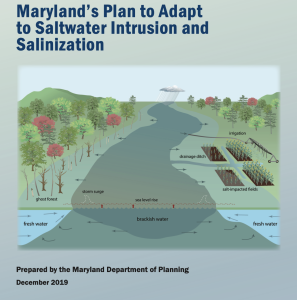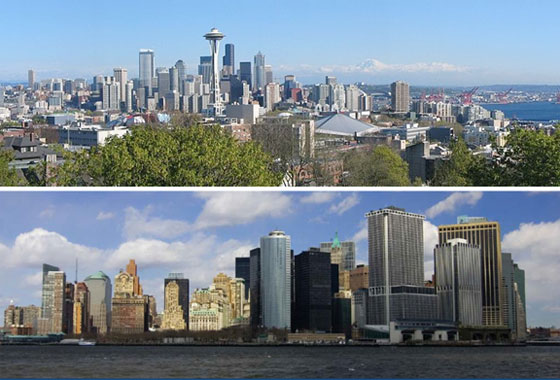Chapter 1: Introduction to Geography
1.8 Human-Environment Interactions
Thinking geographically means understanding how humans and the physical world affect each other. Geographers call this relationship human–environment interactions.
1.8.1 The Mississippi and New Orleans
Human activities have significantly altered the natural environment, often resulting in complex and sometimes adverse consequences. In the case of the Mississippi River, extensive levee systems have been constructed to prevent flooding and to protect agricultural and urban areas. These levees, while effective in controlling immediate flood risks, have altered the river’s natural flow and sediment deposition patterns. Over time, this has led to a number of environmental challenges. The river’s course has been artificially maintained, reducing the natural deposition of sediments that are essential for rebuilding the delta and sustaining wetlands. These changes have exacerbated coastal erosion and weakened natural defenses against storms.

Source: “London Avenue Bridge Memorial.jpg” by Quentin Melson via Wikimedia Commons is licensed under CC BY-SA 4.0.
One prominent example of these challenges is New Orleans. The city, built largely below sea level, relies heavily on an extensive system of levees and floodwalls to protect it from the Mississippi River and storm surges from the Gulf of Mexico. However, these man-made defenses create a paradox: while they prevent immediate flooding, they also contribute to subsidence, as the natural sedimentation that would normally build up the land is prevented. This makes the city more vulnerable over time, requiring continuous efforts to raise and strengthen the levees. Furthermore, the levee systems have led to the loss of surrounding wetlands, which act as natural buffers against storm surges. The destruction caused by Hurricane Katrina in 2005 highlighted these vulnerabilities, demonstrating how human modifications of the environment can lead to increased pressures on communities to react and adapt continuously.
As the environment changes, the pressures on people and infrastructure intensify. In response, communities along the Mississippi River, particularly in New Orleans, have had to invest in increasingly complex and costly measures to mitigate these risks. This includes raising the height of levees, improving drainage systems, and restoring wetlands to regain some of the lost natural protection. These efforts require significant resources and ongoing maintenance, illustrating the dynamic and often cyclical relationship between human actions and environmental responses. As climate change accelerates and sea levels rise, the challenges faced by these communities will likely become more pronounced, necessitating even more innovative and sustainable approaches to living with and managing the natural environment.

Source: A screenshot of the document, ‘Maryland’s Plan to Adapt to Saltwater Intrusion and Salinization’
1.8.2 Sea-level Rise in the Mid-Atlantic Region
The rise in sea level along the mid-Atlantic coast is a pressing example of human-environment interaction, highlighting the impact of climate change on local communities. As global temperatures increase, polar ice caps and glaciers are melting, causing sea levels to rise. This phenomenon is particularly evident along the mid-Atlantic coast of the United States, where the combination of rising sea levels and land subsidence—where the land is gradually sinking—has led to increased encroachment of saltwater into freshwater aquifers.
One significant consequence of this saltwater intrusion is the contamination of drinking water supplies. Many communities in the mid-Atlantic region rely on wells for their freshwater needs. As sea levels rise and saltwater infiltrates these underground aquifers, the quality of the water deteriorates, rendering it unsuitable for consumption and agricultural use. This intrusion poses serious challenges for residents, as they may face increased costs for water treatment or may need to seek alternative sources of fresh water. Additionally, the impact extends to agriculture, as saltwater contamination can damage crops and affect soil fertility.
1.8.3 Tropical Rain Forest Destruction

Source: “Operação Hymenaea, Julho-2016 (29399454651).jpg” by Ibama from Brasil via Wikimedia Commons is licensed under CC BY 2.0.
Another example of such interaction is the clearing of tropical rainforests, a process driven by human activities such as logging, agriculture, and urban development. The removal of these forests significantly alters the local and global environment. Tropical rainforests, which are rich in biodiversity and play a crucial role in regulating the Earth’s climate, act as carbon sinks by absorbing large amounts of carbon dioxide. When these forests are cleared, the stored carbon is released into the atmosphere, contributing to the greenhouse effect and accelerating climate change.
In addition to the direct impact of deforestation, the loss of rainforests has far-reaching consequences for local climates. Forests influence local weather patterns by affecting humidity levels and precipitation. Without the dense canopy of trees to absorb and release moisture, areas that were once covered by rainforests may experience changes in rainfall patterns, leading to more extreme weather conditions such as droughts or floods. These climatic shifts can have significant repercussions for local communities that depend on stable weather for agriculture and water resources. Furthermore, the alteration of climate and the loss of biodiversity can disrupt ecosystems, affecting species migration, survival, and the overall balance of the environment.

Source: “Climate change disturbances of rainforests infographic.jpg” by Kristofer Covey, Fiona Soper, Sunitha Pangala, Angelo Bernardino, Zoe Pagliaro… etc. via Wikimedia Commons is licensed under CC BY 4.0.
1.8.4 Impact of Cities on Climate
The impact of cities on climate is multifaceted, encompassing various environmental, atmospheric, and social effects. Urban areas contribute significantly to climate change through their high concentration of buildings, transportation networks, and industrial activities. These elements collectively generate substantial amounts of greenhouse gases, particularly carbon dioxide (CO2) and methane (CH4), which trap heat in the atmosphere and contribute to global warming.
One of the primary ways cities affect the climate is through the urban heat island (UHI) effect. This phenomenon occurs when urban areas experience higher temperatures than their rural surroundings due to the dense concentration of buildings, roads, and other heat-absorbing surfaces. These surfaces absorb and retain heat more effectively than natural landscapes, leading to elevated temperatures in cities. The UHI effect exacerbates energy consumption, as higher temperatures increase the demand for air conditioning, further contributing to greenhouse gas emissions.
Cities also impact climate through their significant energy consumption and waste production. Urban centers are major hubs of economic activity, leading to high energy use for lighting, heating, cooling, and transportation. This energy demand often relies on fossil fuels, which release additional greenhouse gases into the atmosphere. Furthermore, cities produce large quantities of waste, including organic materials that decompose and release methane—a potent greenhouse gas—into the atmosphere. The combination of these factors makes urban areas critical focus points for climate mitigation efforts, as reducing emissions, enhancing energy efficiency, and managing waste are essential for addressing the broader challenges of climate change.

Source: “Seattle and New York City” retrieved from “A tale of two cities” by Bob Silberg, Science Writer, via NASA: Global Climate Change.
Such mitigation efforts are exemplified by cities like Seattle and New York City, which, despite their vastly different sizes and lifestyles, both stand out as leaders in tackling climate issues. According to NASA’s global climate change publication, These cities showcase how targeted urban strategies and space-based data can drive significant progress in reducing environmental impact and adapting to changing conditions.in addressing climate change by utilizing space-based data. Seattle, with a population of around 600,000, and New York City, with 8.2 million residents, have each set ambitious goals in 2010 for reducing greenhouse gas emissions. Seattle aims to cut emissions by 7% by 2012, 30% by 2024, and 80% by 2050, while New York targets a 30% reduction from 2005 levels by 2030. Both cities have made significant progress toward these goals, focusing on reducing emissions from buildings and transportation, which are the primary sources of their greenhouse gases. New York has enacted stringent energy efficiency regulations for large buildings, whereas Seattle is working to decrease car usage and promote alternative transportation methods.

